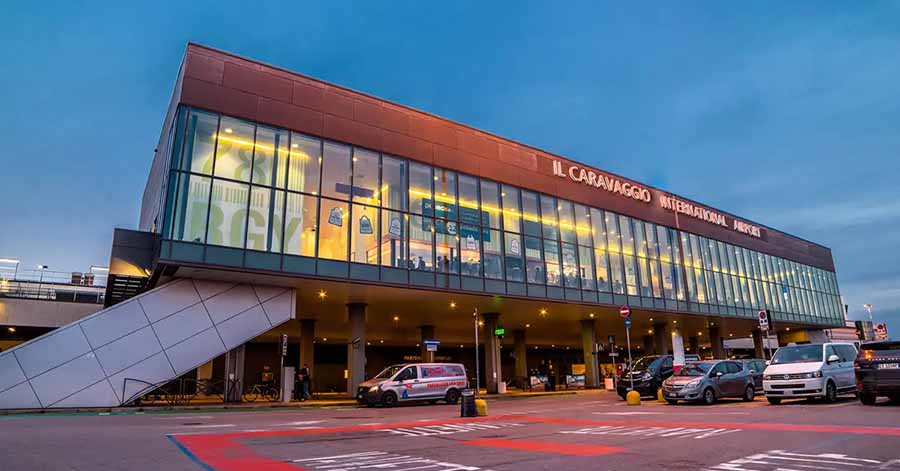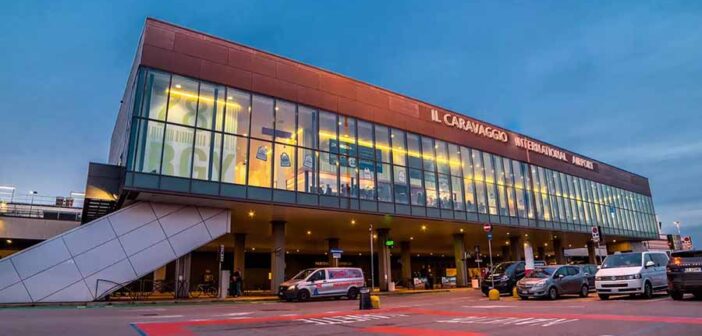
Milan Bergamo Airport, officially Il Caravaggio International Airport, lies 3.7 kilometres southeast of Bergamo and 45 kilometres northeast of Milan, serving as a key hub for low-cost carriers like Ryanair and Wizz Air. Handling nearly 17.4 million passengers in 2024, it ranks as Italy’s third busiest airport, offering a practical gateway to the Lombardy region. The passenger experience is streamlined, with a single terminal split into Schengen (Gates A1-A15) and non-Schengen (Gates B1-B5) zones, making navigation straightforward. The compact layout, with check-in desks on the ground floor and departures on the first, ensures short walking distances, though the terminal can feel crowded during peak hours. Clear signage in English and Italian guides travellers through security and to gates, with only two jet-bridge gates; others require bus transfers or tarmac walks.
Accessing the airport is convenient, with multiple transport options. The Airport Bus (ATB Line 1) connects to Bergamo’s railway station in about 15 minutes for €2.30, with tickets valid for 90 minutes across the city’s network, including funiculars to Città Alta. For Milan, shuttle services like Autostradale, OrioShuttle, and Terravision run to Milano Centrale in roughly 50-75 minutes, costing €5-€16, with frequent departures from the arrivals area.
Taxis to Bergamo city centre cost around €20 for the 8-kilometre trip, while a ride to Milan, 57 kilometres away, averages €100-€120, subject to traffic delays. A railway station is under construction, set to open in 2026, but for now, travellers can take a bus to Bergamo station and connect to regional trains.
The airport offers a solid range of dining and retail. After security, passengers find a mix of cafes like Berry & Coffee and Green Bar Gnam for snacks, alongside Beerstrotheque Elav for craft beers and artisan dishes. La Marianna serves ice cream and pastries, while duty-free shops and souvenir stores cater to shopping needs. Retail is modest but practical, with essentials and local products available. Facilities include free Wi-Fi via the ‘BGY_FREE’ network, currency exchange, ATMs, and luggage storage at €3-€5 per day. Two lounges, the Check-in Lounge and HelloSky Lounge, offer snacks, drinks, and workstations for €21.50-€35, with fast-track security access for quicker screening. Dedicated paths, ramps, and a Sala Amica waiting room ensure accessibility for passengers with reduced mobility.
On-time performance is generally reliable, bolstered by the airport’s role as a Ryanair hub with tight schedules, but delays can occur. Peak morning and evening hours, when numerous flights depart, often lead to congestion at check-in and security, with queues sometimes lasting up to 30 minutes. Passport control for non-EU travellers can add further delays due to biometric checks. Weather disruptions or operational issues, such as staff shortages, may also impact schedules, so arriving three hours early for international flights is wise.
Connections are efficient, particularly with Ryanair’s connecting flights on 25 routes, allowing airside transfers and through-checked baggage. The Bergamolynk service supports seamless self-connections for separate tickets, with minimum connection times of 30 minutes for all flight types. However, passengers on non-connected flights may need to exit, reclaim luggage, and recheck, adding 60-90 minutes to the process. The single terminal eliminates inter-terminal transfers, but busy periods can slow security re-entry. Potential delays to watch for include long security lines, especially in summer, and occasional inefficiencies at passport control, particularly for non-Schengen flights.
Milan Bergamo Airport delivers a functional experience tailored to budget travellers. Its compact design, accessible transport links, and adequate amenities make it a practical choice for exploring Bergamo, Milan, or beyond, provided travellers plan for peak-time congestion.
Ryanair
Ryanair operates from the main terminal, with check-in desks typically in the check-in area (desks 1–20). Exact assignments are displayed on airport screens. Flights to Ireland (Dublin) usually depart from the non Schengen gates ( B1–B10). Gates are confirmed on departure boards. To find the non Schengen gates:
- Proceed past the main departure area: After the security checks, you’ll be in the main departure hall where the Schengen gates (Zone A) are located on the first floor.
- Go downstairs to the non-Schengen area: To access the non-Schengen gates, you need to go to the lower level.
- Find Zone B gates: This area will have the B gates, including B1, B2, B3, B4, and B5




